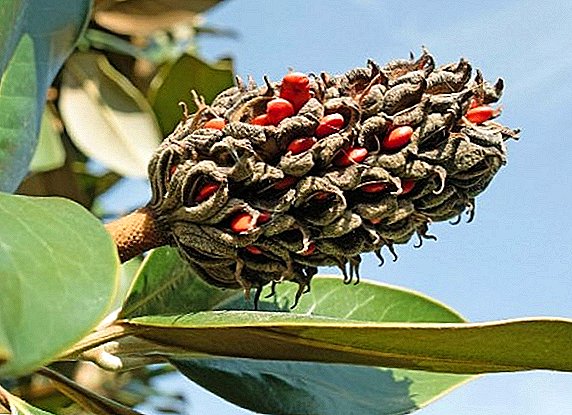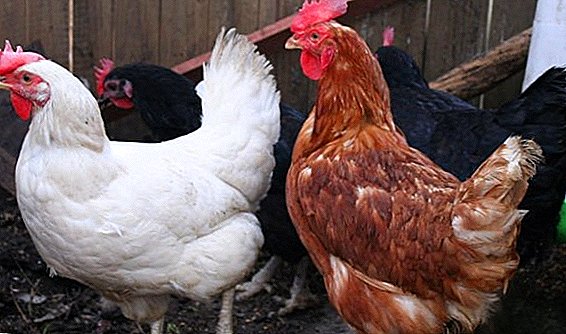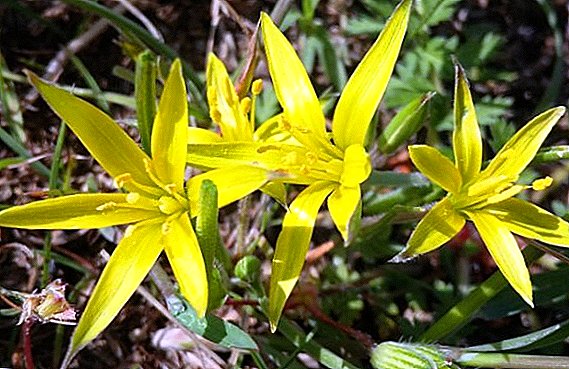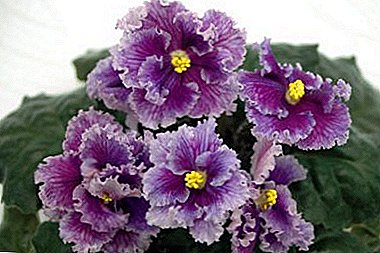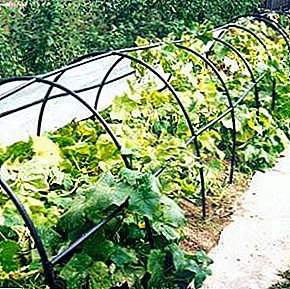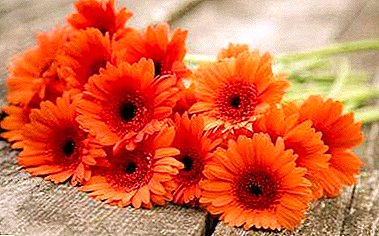
Gerbera is a perennial herbaceous plant, which belongs to the Astrov family. From a thick stalk located underground, a rosette with long pinnate leaves with sharp edges grows.
Peduncle has no leaves, it is lowered and reaches from 30 to 65 cm in height. The love of gardeners of gerberas did not deserve the track for a long time: only at the end of the 19th century.
Particularly rapidly began to grow in popularity of these flowers in the last fifty years. From African wild plants, gerberas have turned into exquisite favorites of European flower growers.
Botanical description and history
This plant is a herbaceous perennial of the Astrov family. The stem, from which the socket comes out with elongated leaf plates, is located underground. Gerbera peduncle growing without foliageIts height reaches 30-65 centimeters.
Most often, the flower basket is quite large, with petals in the form of reeds. They can be located in one or several rows.
Outdoors gerberas can bloom all summer season. After flowering seed boxes are formed, the maturation of which falls on the end of summer - the beginning of autumn.
If we talk about the history of the African wonders, here it is worth remembering one beautiful legend. It speaks of a heavenly angel who once kindled feelings for the earthly girl. But this angel was well aware that they could not be together.
Therefore, I decided to give the girl a gift in the form of a star glade. These stars turned into orange gerberas. The girl, seeing her talent, just smiled. Since then, these stars-lights have become a symbol of sincerity.
Description of appearance and features
Sheet plate on the edges as if cut. Behind their density, they hide short stalks. Each flower develops separately. Buds can reach from 5 to 15 centimeters in diameter. There are flower baskets on flower arrows.
The peculiarity of orange gerberas is that there are several varieties of flowers of this shade.
The most common ones are:
- Sweet caroline. Different orange petals with yellow tips.
- Orangina. Tongues of fiery color, but with golden hues.
- Sweet honey. The whole flower is orange, and its core is yellow.
A photo
Next you can see the photo of orange Gerbers:





How and where to plant?
Orange gerbera planted in open ground seedlings. For the first time, it may seem difficult to carry out this procedure, but over time, a novice gardener will do it (we tell in detail here how correctly gerberas are planted in open ground and what follow-up care they need.
The order of planting flowers
- Purchase of planting material. If you have grown gerberas before, you can collect seeds from the box. If you just decided to acquire these flowers, the seeds can be purchased at a specialty store.
We recommend that you select only proven manufacturers and pay special attention to shelf life.
- To determine the date of planting, focus on the fact that gerberas begin to bloom after one year of growth and development.
- Boxes for seedlings do not have to be deep, because soon you will have to dive seedlings.
Do not forget about a good drainage layer.
- To prepare a soil mixture for seedlings on their own, you need to take sand, humus and sheet soil in equal proportions. But it would be better to buy ready-made substrate in a flower shop. Perfect soil for roses.
- It is good to pour the prepared mixture with a solution of potassium permanganate.
- Sowing material is planted, leaving a square of 2 centimeters on each seed and squeezing them slightly.
- Place for seedlings choose warm and dark.
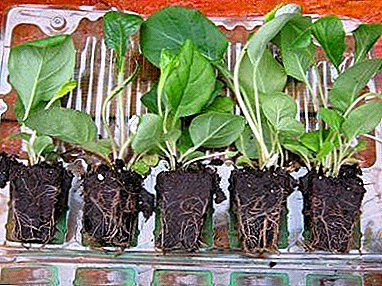 Usually shoots are shown after seven days.
Usually shoots are shown after seven days.- After the first three leaves appear, the seedlings can be swooped down into separate containers.
- As soon as you notice more than five leaves, you need to carry out a pick a second time, while using deeper pots (their diameter should reach 10-12 cm).
- Do not forget to feed seedlings with mineral fertilizers at least once every 15 days.
It is possible to plant seedlings in open ground only after the night temperature outside ceases to fall below 18 degrees.
All the nuances of growing gerberas from seeds are described in detail in this material.
Lighting and location
Orange Gerbera - a plant that requires a lot of light.. Therefore, when choosing the location of the flower, it is better to give preference to the southern, in extreme cases - to the eastern sides. In the northern part of the room, the flower will experience a constant lack of light.
In the warm period of the year it will be very useful to take the gerbera to the open air.
To accustom the plant to a new temperature and light regime gradually.
In the autumn and winter, it is worth thinking about additional lighting. for the "home sun".
Soil requirements
Gerberas have no special preferences for soil at all.
You can take any universal land by adding vermiculite and charcoal, peat, leaf earth and sand. If you do not use these additives, you will protect the plant from rotting of the root system. But in this case, you will need to regularly feed the flowers. An important condition for the good development of the gerbera is the presence of a drainage layer, which can be created with the help of expanded clay, pebbles or crushed shells.
Basics of proper care
- Temperature conditions. Gerbers love warmly. Therefore, indoors or outdoors, the temperature should be maintained at a level of 22-24 degrees above zero.
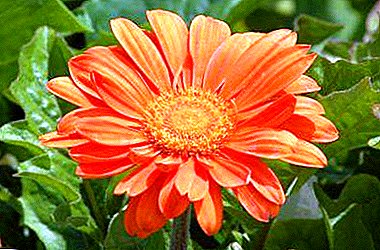 During flowering, this plant can not withstand day and night temperature extremes.
During flowering, this plant can not withstand day and night temperature extremes.This should be taken into account if the florist wants to enjoy the “lights” for as long as possible. At the end of flowering, the air temperature should be gradually reduced so that by the winter period it reaches only 14 degrees above zero.
- Light mode. There should be a lot of light. But the main task of the grower is to provide diffused light and to help the gerbera not to fall under direct sunlight, which can burn the leaf plates of the plant.
If the flowerpot with a flower is located on the south side of the room, in the hot hours you need to curtain the window with a reflective foil. The duration of flowering depends on the length of daylight: it must be at least twelve hours.
- Watering. Water for moistening the soil should be soft and purified, have a room temperature.
It is important during watering to ensure that water does not fall on a sheet outlet.
Watering is necessary so that the soil is not overdried for a long time. During rest, moistening of the substrate should be slightly reduced, but not allowed to drain the earth.
Spray the plant itself is not necessary. It will be enough to humidify the air around the gerbera.
An important condition for the full growth and development of the flower is to provide expanded clay, pebbles or moss in the pan. This will help avoid root decay.
- Fertilizer. It is enough for flower growers to feed gerbera only once every 15 days with special ready-made complexes intended for flowering plants.
- Transfer. Every year it is necessary to change the gerbera "place of residence" to a more spacious one. When transplanting, you need to carefully ensure that the ground does not get into a sheet outlet, as well as ensure that this outlet is not very recessed.
It is necessary to remove faded buds in time so that they do not inhibit the growth and development of the gerbera and do not provoke its diseases.
- Why indoor gerberas can not bloom?
- What if gerbera leaves turn yellow and why can it happen?
- Important rules for caring for the flower - what you should not do when growing gerberas in pots?
- Proper care for room gerbera at home.
Breeding
 Gerbera propagated by seed, dividing a bush or grafting. Cuttings can be cut from young healthy shoots and planted them in the ground. Next - care is the same as for seedlings.
Gerbera propagated by seed, dividing a bush or grafting. Cuttings can be cut from young healthy shoots and planted them in the ground. Next - care is the same as for seedlings.
You can divide only the bush that has reached the age of not less than three years, but not more than five. To care for a divided bush should be the same as for an adult plant.
Flower growers will open their buds only a year after dividing the bush. When planting young seedlings need to ensure that the sheet rosette was 1-2 centimeters above the ground. About all ways of breeding gerbers at home, find here.
Diseases and pests
This type of flowers can be attacked by the following parasites:
- Mealy dew. It develops in conditions of wetland soil, high humidity and irregular ventilation of the room. By the way, for the same reason, the gerbera may begin rotting the root system.
The first signs of development of powdery mildew will give out leaves - they will become yellow in color or else they will show pigmentation. To combat this pest, you need to eliminate all the shortcomings in the cultivation of a flower, remove the affected parts and spray the whole plant with Fitosporin-M.
- Aphid, shchitovki, whiteflies and mites. Usually they appear due to a surplus of nitrogen in the soil, as well as because of irrigation with cold water and an abrupt change in temperature.
To cope with pests, you need to start caring for the plant again, and also treat it with fungicides. This should be done several times with a break of five days.
- Spider mite. To notice it with the naked eye is not so easy. Therefore, experts recommend as often as possible to examine the gerbera for infection.
A spider mite is usually destroyed with the help of a soap solution (they need to wipe all parts of the plant) or an insecticide. The procedure is carried out 2-3 times with an interval of seven days.
On the common diseases of gerberas and effective methods of dealing with them, read our article.
Conclusion
Summing up, we can safely say that orange gerberas are very complex plants that require constant close attention. But their fascinating appearance is worth all the efforts made during the cultivation.


 Usually shoots are shown after seven days.
Usually shoots are shown after seven days. During flowering, this plant can not withstand day and night temperature extremes.
During flowering, this plant can not withstand day and night temperature extremes.